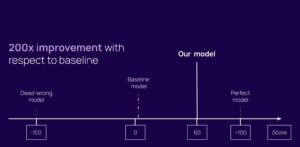Employee Churn Rate Prediction with AI
With AI for Churn Prediction, Enterprises Can Reduce Costs, Retain Key Staff & Increase Revenue Through Advanced Turnover Prediction....

Employee churn prediction, (otherwise known as employee turnover prediction) involves identifying which employees are likely to resign from an organisation. This process is crucial for businesses to manage their workforce effectively and reduce the costs associated with high turnover rates. By forecasting which employees are most likely to resign, businesses may address potential causes, enhance employee satisfaction and retain key staff members.
Efficient churn management not only saves money on hiring and training new employees, but it also protects key institutional knowledge and cultivates a more engaged and committed team. In 2022, the turnover increased from 16.2% in 2021 to 23.4% in 2022. This is the highest percentage seen since 2019; efficient churn management is becoming increasingly valuable.
The Challenge of Advisor Churn
Advisor turnover poses a unique set of issues. Advisors are key employees. The frequently retain crucial customer connections and have specialised knowledge that is hugely valuable to successful companies. When these advisors leave, they take key business insights, relationships, and knowledge with them. This can result in customer loss or lower service quality for the organisation.
This loss is especially evident in sectors where personal connections and trust are crucial, like finance, consulting, and legal services. Advisor turnover can disrupt ongoing projects, result in the loss of vital institutional expertise, and require significant effort in hiring and training new people.
Losing valuable team members has far-reaching consequences beyond the current labour shortage. It may result in increased workload for remaining employees, lower service or product quality, and a negative influence on the company’s reputation.
We worked with a finance company facing high advisor churn. During this project, we discovered that the churn of a Sales advisor valued at $1million could lose a company $1million in revenue. If the same representative was prevented from churning, that amount was safeguarded for the company.
The expenses associated with high turnover rates are not only financial; they also include the time and resources spent on locating and integrating new employees into the corporate culture and workflow. That’s why efficiently managing churn is critical for a company’s stability, growth, and competitive advantage.
AI-Powered Churn Prediction:
Artificial Intelligence has revolutionised the accuracy and efficacy of churn prediction. AI systems can analyse massive volumes of data, including subtle trends in employee behaviour and mindset that humans may miss. These algorithms can identify risk variables and predict turnover with greater accuracy than traditional techniques.
With AI, there are four possible outcomes of churn rate prediction:
- No-Action: No action performed to prevent churn,
- Random Selection: Churning reps are randomly picked from known distribution,
- Machine Learning: Churning reps are identified with Machine Learning,
- Crystal Ball: Churning reps are known.
On top of that, AI can help in decision-making by providing insights and recommendations based on predictive analysis. This not only improves prediction accuracy but also allows for more strategic, data-driven decisions on staff retention and engagement.
Machine learning algorithms, predictive analytics, and data mining are all important AI tools for predicting churn. This is thanks to their analysis of historical data, employee interactions, and performance indicators, respectively. Companies can gain a better understanding of employee satisfaction and alerts when employees are likely to churn by utilising these AI solutions.
Early detection using AI enables businesses to implement targeted retention measures, such as addressing specific grievances, providing professional development opportunities, and enhancing working circumstances. This proactive strategy not only helps to retain valuable personnel, but it also promotes a more positive and productive work culture.
By efficiently using AI for churn prediction, businesses can significantly reduce the expenses and interruptions associated with high turnover, resulting in a more stable and successful business.
Case Study Overview:
Gemmo AI undertook a project for a company facing high advisor churn. Our project aimed to build a predictive AI model focused on helping the company overcome this challenge. The goals of our AI model were as follows:
- Target most productive representatives
- Identify success metrics
- Improve performance over a simpler baseline model
Analysing Historical Data
The project employed a custom machine learning model to carefully analyse historical data, an important step in understanding and predicting advisor churn. Using AI, the Gemmo AI team was able to sort through enormous volumes of data that would have been overwhelming for conventional analytical techniques. This data contained essential performance measures and detailed patterns of advisor behaviour over time.
Large datasets can be analysed by AI algorithms to find patterns and connections. Machine learning algorithms are particularly effective at this. In this project. Data like this that is frequently subtle and complex is almost impossible to detect without the strong pattern recognition capabilities of AI. Examining advisor behaviour patterns like engagement levels, work habits, and changes in everyday tasks, offered more insight into potential symptoms of unhappiness or disengagement within the company.
AI was able to draw a detailed picture of what circumstances and behaviours lead to advisor churn. This knowledge is essential for forecasting staff turnover and setting retention plans into action. With the use of the project’s AI-driven approach, advisor churn may be better understood and predicted, revealing not only who would depart but also why and when. These predictions enabled prompt and focused interventions.
Predictive Modelling
Our predictive model methodically learns from past data to identify and decipher intricate patterns and signals that could indicate an advisor or employee is about to leave.
The predictive model works by examining various indicators. These could be measurable indicators like a decline in customer satisfaction or an obvious change in performance evaluations. It also explores more subtle topics, such as adjustments to client or corporate communication styles, changes to work schedules, and participation in group activities. These signs—which are often less obvious and more intricate—are essential in understanding the underlying discontent or disengagement among staff.
Proactive Retention Strategies
Our model’s insights offer a thorough understanding of the factors influencing advisor turnover. Different targeted measures are informed by this machine learning model’s understanding, which can lead to more tailored solutions being put into place.
For example, employers could respond with tailored growth opportunities, improved mentorship programmes, or changes to work circumstances if AI shows that a reduction in engagement or job satisfaction is a significant issue. Similarly, if the statistics point to problems with work-life balance, remedies can include more help and resources for work-related stress, or more flexible work schedules.
AI can also assist in determining when these interventions should take place. Through constant observation of advisor behaviour and performance, machine learning systems can identify the best times to deploy retention techniques and maximise their efficiency. This timely approach is essential since remedies are most effective when implemented before an advisor’s decision to leave is finalised.
Measurable Outcomes:
One of the main markers of our model’s effectiveness was a discernible decline in advisor turnover rates. In addition to stabilising the workforce, this decrease in turnover also lessens the financial burden and interruptions brought on by regular replacement and retraining of staff.
The efficiency of the project is also evident in improved company performance measures. Higher overall productivity, improved client connections, and higher-quality services come from an engaged employee workforce.
Results and Insights
There was a 200x improvement in churn prediction over traditional methods. This improvement demonstrates our predictive model’s increased ability to correctly identify at-risk employees. Traditional methods did not offer the comprehensive data interpretation and sophisticated analysis that the AI model offered.

A noteworthy accomplishment of our AI model was a 600-fold increase in feature evaluation speed. With traditional methods, this work would be difficult, if not impossible. However, the AI model’s ability to quickly analyse and interpret large amounts of data is demonstrated by this significant boost in efficiency.
Finally, applying SHAP analysis to every representative provided a more profound understanding of the variables impacting turnover. Each advisor was able to receive a more customised and successful intervention plan due to this comprehensive approach.
Final Thoughts on Gemmo AI’s Churn Rate Prediction Model
Our AI model has proven to be able to detect and handle issues such as advisor turnover with great efficiency, accuracy, and in-depth insights.
The integration of AI into strategic decision-making processes offers a significant advantage. It enables businesses to harness data-driven insights for proactive decision-making, ensuring a more dynamic and responsive approach to workforce management. AI is a valuable tool for navigating the complicated business contexts of today.
Its benefits, such as decreased churn rates, significant cost savings, and increased overall performance, demonstrate this. AI can completely change business operations and strategic decision-making; this potential is becoming increasingly evident as it develops.



